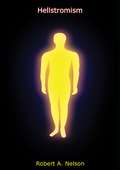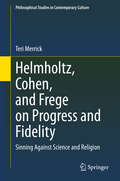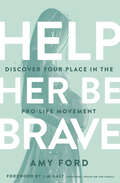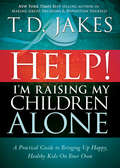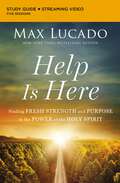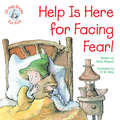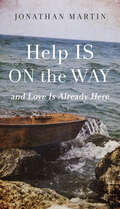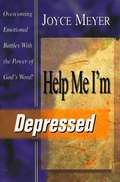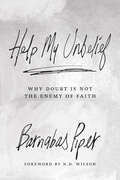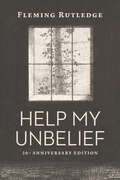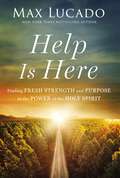- Table View
- List View
Hello, Little Dreamer
by Kathie Lee GiffordBeloved talk show host Kathie Lee Gifford inspires children to follow God's dreams for them in this picture book about finding your passions and growing into God&’s plan. Each child has dreams to discover over their lifetime, and Hello, Little Dreamer helps families celebrate each child's God-given purpose in the world.Children glow with joy and a sense of security when they know God made them for a purpose. Four-time Emmy Award winner and New York Times bestselling author Kathie Lee Gifford reminds preschoolers and elementary-aged kids that God has been dreaming for them since even before they were born. Some dreams reveal themselves quickly while others take time to develop, but each dream adds to the beautiful picture of who a child is becoming.This hopeful and affirming picture book for 4 to 8-year-oldsencourages children to try new things and explore their interests, strengths, and talents to discover who God made them to beteaches that some dreams take time to find and you should never give up tryinghelps children rest in God's love for them and have confidence in themselves as His creationfeatures a bright, decorative cover and wonder-filled illustrations of diverse children from Anita Schmidtis an uplifting choice for shared story times and bedtime reading or for independent reading by older childrenThis is an ideal book to give kids for birthdays, adoption parties, or other special occasions such as preschool or kindergarten graduation. With its encouraging, biblically based words, Hello, Little Dreamer will encourage any child to trust that they have an amazing role in God's story.
Hello, My Name Is: Discovering Your True Identity
by Matthew WestThe world goes out of its way to make you believe you are not good enough. Maybe you aren't sure you like where you've been, or who you've become. Maybe someone has made you believe a lie about who you are by speaking damaging words to you. The discovery of our true identities does not begin by looking within ourselves, but by looking to the One who made us. Hello, My Name Is will inspire you to not wear the nametag that someone else gave you, but to wear the name of who God says you are. Your name may be "Lonely" . . . He calls you Friend. Your name may be "Failure" . . . He calls you Redeemed. Your name may be "Broken" . . . He calls you Beloved. It is time to tear off the false nametags that cover up your true identity. Understanding who you are begins with knowing Whose you are so you can embrace your destiny as a child of the one true King. "Hello, My Name Is will silence the lies of the enemy so you can hear God whisper, 'You are mine. You are wanted. You are so incredibly loved.'" —Lysa Terkeurst, New York Times best-selling author and president of Proverbs 31 Ministries "Hello, My Name Is gets to the heart of an issue that haunts the homeless and the hero, the kid and the king, the disabled and the diva—our identity." —Randy Frazee, Senior Minister at Oak Hills Church, author of The Heart of the Story Matthew West brings the rare combination of songwriter an pastor to his ministry. He is a modern-day King David, creating Psalms that touch the heart of God and God’s children. Now, as an added blessing to us all, he has compiled his thoughts into a book. A person can almost hear Matthew sing through the pages. I’m deeply grateful for this work, this singer, this friend. —Max Lucado, New York Times best-selling author Matthew West has always written honestly in his songs and stories. In his latest book, Hello, My Name Is, Matthew may offer his greatest truth yet: how to discover our God-given identity while building a closer relationship with our Lord. I gained a lot of insight while reading this book, and I know you will as well. —Scotty McCreery, ACM, BMI, and CMT award-winning country music entertainer and author of Go Big or Go Home: The Journey Toward the Dream
Hello, Soul!: Everyday Ways to Begin Awakening Your Spirituality
by Alena ChapmanWhat would it feel like to ask, “Are you there Soul?” And you hear, “I am here.” How would it feel to always have that very in-tuned connection to the deepest part of you – Your Soul? With Hello, Soul!, readers join Alena Chapman on her journey of learning how to connect and live connected to her Soul. They learn each step she took in order to do so and how to create their own journey. Hello, Soul! helps readers feel a strong flow and ease in life knowing that they are whole and in sync with their true self on every level. It brings readers peace and the feeling that everything will always turn out well.
Hello, Stars!: A Sleepytime Tale of God's Loving Presence
by Sheila WalshReassurance that the Stars--and God's Love Will Always Shine!One evening after bedtime, young Sam decides that God is like the stars twinkling outside his bedroom window--happy, bright, and bathing him with light. The next day, after his beloved stuffed bear disappears, Sam asks God to help him find his favorite friend. When the cuddly bear doesn't show up, Sam decides that God is gone and cannot hear his prayers. But Sam is about to learn a very important lesson: God is always with us and never leaves...
Hello, Tomorrow!: The Transformational Power of Vision
by Cindy TrimmFEATURES AND BENEFITSEmpowers readers to apply God&’s Word to access His best for their futureReveals daily disciplines to activate God&’s power in their livesBuilding on the teaching in her best-selling book Commanding Your Morning, Cindy Trimm shows readers how to craft a brighter tomorrow by using spoken declarations to activate God&’s power in their lives. Based upon the biblical principle that everything God has decreed is available to all, this book arms the believer with the kingdom principles that will empower them to use God&’s power and authority to enforce, establish, and institute God&’s will for their future, and dominate the enemy. Through Hello, Tomorrow! readers will discover how to build a bridge to their future, put themselves where they see themselves, write their own history, and dare to do something great.
Hellstromism
by Robert A. NelsonRobert A. Nelson’s authoritative treatise on the life and sensational mind reading feats of Axel Hellstrom, a German muscle reader, mentalist and stage magician who redefined the art of muscle reading.Hellstrom was a man who baffled many of the brightest scientific and magical minds of his time by singlehandedly taking this ability to incredible, new heights—so much so, in fact, that for many magicians his name remains synonymous with “Contact” and “Non-Contact” Mind Reading—“Hellstromism!”Nelson, the long-time professional mentalist and mentalism/magic dealer, was personally coached by Hellstrom before the celebrated mind reader’s death.In this book, he painstakingly explains the inner workings of Hellstrom’s miracles. Every phase is covered in detail: from choosing and working with subjects to suggested performance routines.You will learn everything you need to know to begin developing your own abilities, as well as what is required to take your performance to the next level.A truly informative and fascinating read, written by an expert who was sincere and passionate about the possibilities “Hellstromism” has to offer.Originally published 1935, this edition contains the author’s additional chapter titled “Later day experiments in Hellstromism,” dated April 15, 1941.
Helmholtz, Cohen, and Frege on Progress and Fidelity: Sinning Against Science and Religion (Philosophical Studies in Contemporary Culture #27)
by Teri MerrickThis book examines the views of Hermann Helmholtz, Hermann Cohen and Gottlob Frege in reaction to the epistemic crises induced by rapid changes in 19th century scientific practice. Besides addressing longstanding interpretive puzzles of interest to Frege scholars, the book extracts precepts for rationally responding to paradigm shifts in scientific and religious traditions. Cohen’s work in particular is held up as an example of wisely navigating epistemic and hermeneutical crises in science and religion. The book will appeal to philosophers and historians of science or religion, especially to those concerned with the epistemic challenges posed by Kuhn’s The Structure of Scientific Revolutions.
Help Her Be Brave: Discover Your Place in the Pro-Life Movement
by Amy FordDiscover your place in the pro-life movement.What if we lived in a world where every woman with an unplanned pregnancy always felt empowered to choose life for her unborn baby? To create that kind of change, it will take all of us. As the church, we can play a powerful role in making abortion unthinkable. With Help Her Be Brave, you can discover your part in saving lives and find your pro-life passion. This includes how to: Learn practical ways to get involved using your unique gifts and talentsFind women with unexpected pregnancies and connect them to supportUse your influence and be a voice for the voicelessMake your church a refuge for abortion vulnerable womenIf abortion became illegal today, the church isn&’t ready to help women practically, spiritually and emotionally. It&’s time to change that. We can&’t look away any longer. This is our moment for us to stand up and help her be brave.
Help Her Be Brave: Discover Your Place in the Pro-Life Movement
by Amy FordDiscover your place in the pro-life movement.What if we lived in a world where every woman with an unplanned pregnancy always felt empowered to choose life for her unborn baby? To create that kind of change, it will take all of us. As the church, we can play a powerful role in making abortion unthinkable. With Help Her Be Brave, you can discover your part in saving lives and find your pro-life passion. This includes how to: Learn practical ways to get involved using your unique gifts and talentsFind women with unexpected pregnancies and connect them to supportUse your influence and be a voice for the voicelessMake your church a refuge for abortion vulnerable womenIf abortion became illegal today, the church isn&’t ready to help women practically, spiritually and emotionally. It&’s time to change that. We can&’t look away any longer. This is our moment for us to stand up and help her be brave.
Help I'm Hurting
by Bill OswaltThis book talks about the concept of sanctification and the biblical concept of rewards.
Help I'm Raising My Children Alone: A Guide for Single Parents and Those Who Sometimes Feel They Are Single
by T.D. JakesThe loss of a spouse through death, divorce, or even abandonment can leave a mom or dad feeling uncertain about how to pull the family together and raise spiritually healthy children. In this best-selling book, Bishop T. D. Jakes, the father of five children, offers hope, encouragement, and biblical advice for single parents--and for those who feel as if they are single. Using discussion questions, interactive parent/child activities, and prayers at the end of each chapter, Jakes helps you learn how to embrace your family’s future and let go of your painful past as you reflect on topics including: Learn how to accept unexpected changes. Know that past failure does not prevent future success. Learn how to love imperfect people. Turn pain into power. Know that it is OK to ask for help.
Help Is Here Bible Study Guide plus Streaming Video: Finding Fresh Strength and Purpose in the Power of the Holy Spirit
by Max LucadoWhen you feel powerless . . . help is hereBills pile up. Savings go down. Marriages go south. Work goes off the rails. Stress goes off the charts. It&’s all too much to take on by yourself.Fortunately, you don&’t have to take it all on yourself. In fact, God never intended for you to do so. He has provided heaven-sent help to walk with you, guide you, and shoulder the load. Someone who never gets tired. Someone who is strong and powerful. Someone who is unhindered by what hinders us. Someone who is always nearby.Interested? If so, join Max Lucado in this five-session study to learn more about this &“helper&” whom we know as the Holy Spirit. You will receive the tools and encouragement you need to become joyful, enthusiastic, and empowered as you draw closer to God; learn who the Spirit is and how he can help you; find true rest and peace as you let him carry your burdens; and discover your unique gifts to further God&’s kingdom.Help Is Here reminds us that our Good Shepherd doesn&’t just feed us; he leads us. He does more than correct us; he directs us. God keeps us on track—and best of all, he&’s commissioned the Holy Spirit to guide us down the winding roads of life, wherever they may lead us.Sessions and video run times:Our Powerful Ally (17:00)Our Strength and Guide (16:30)Our Peace and Guarantee (18:30)Our Intercessor and Advocate (16:30)Our Gift-Giver of Life (16:30)This study guide has everything you need for a full Bible study experience, including:The study guide itself—with discussion and reflection questions, video notes, and a leader's guide.An individual access code to stream all video sessions online. (DVD also available separately.)Streaming video access code included. Access code subject to expiration after 12/31/2027. Code may be redeemed only by the recipient of this package. Code may not be transferred or sold separately from this package. Internet connection required. Void where prohibited, taxed, or restricted by law. Additional offer details inside.
Help Is Here for Facing Fear!
by Molly Wigand R. W. AlleyThe world can be a scary place--especially when just about everybody is bigger than you and so many experiences are brand-new. Childhood fear is normal. But if it starts to interfere with everyday life, it becomes a problem for a child--and caring adults. This delightfully illustrated book gives simple, concrete advice for dealing with childhood fears and worries. Kids can learn to live full of confidence, free of fear. Help is here!
Help Is on the Way: And Love Is Already Here
by Jonathan MartinDisappointed dreams, broken relationships, identity crises, vocational hang-ups, wounds from the past--there are so many ways life can send us crashing up against the rocks.So when life leaves you shipwrecked, what can you do? In Help Is On the Way, excerpted from his full-length book How to Survive a Shipwreck, author and pastor Jonathan Martin draws from his own shipwreck experiences to uncover how God meets us in our most critical moment, and exactly what we need to hang on until morning. Through fresh biblical insights and strong practical truth, Help Is On the Way will illuminate:How to practice self-care in the midst of a shipwreck (and why this is not selfish)What to hold on to at all costs, and what to let goHow to gain clarity, composure, and a new way of knowing God on the other side of the stormWhere God's love is in all of this--even the hard parts
Help Me! I'm Depressed: Overcoming Emotional Battles With the Power of God's Word! (Help Me Series)
by Joyce Meyer"Bestselling author Joyce Meyer brings powerful insight from the Scriptures and from her own experience to help you win over depression! You will discover how to walk by faith and not by feelings, the power of willful rejoicing, and the vital role of forgiveness. As believers, joy is not something we try to manufacture--it is something already within us waiting to be released! The victory over depression is yours through Jesus Christ! Rise up in His power and take back your position of joy and freedom today!"
Help Me, God, I'm a Parent: Honest Prayers for Hectic Days and Endless Nights
by Bunmi LaditanTrade your fear and anxiety about your children for peace, calm, and confidence in the God who loves and guides you as you parent.Bestselling author and mom blogger Bunmi Laditan vulnerably shares the prayers she's prayed for her children as inspiration for your own prayer life. Refreshingly relatable, bravely honest, and deeply heartwarming, Help Me, God, I'm a Parent meets you right where you're at and gives voice to the thoughts everyone--even you--has about parenthood that they are afraid to say out loud.In the way only she can, Bunmi echoes the same fears, joys, delights, loneliness, regrets, and love you have in your heart through prayers that . . .Bask in the awe and wonder of parentingSavor joyous moments and big accomplishmentsMake you laugh when you need it mostRejoice in the love you have for your children and the love God has for youAlleviate worry and anxiety about your children and their futuresBestow peace and calm in those I'm-at-the-end-of-my-rope momentsSeek wisdom when the advice of the world fails youOffer humble thanks to a good God for the blessings we see and those we don'tNo prayer is more powerful than the one prayed by a parent for their child. Experience today how prayer can change not only your own life but the lives of your children.
Help Me, Jesus! I Have Nothing to Wear!: The Go-To Guide for All Shapes and Sizes
by Shari BraendelIn Help Me, Jesus! I Have Nothing To Wear! Shari Braendel teaches you how to finally love the body God gave you and how to look your best—from discovering your body shape and learning to dress it, to finding your best colors, to wearing jeans that flatter your thighs and hips, to finding the best places to shop to suit your unique personal style. Many of us are watching reality TV shows to get a clue on how to dress right and look good. We hungrily purchase fashion magazines any time the cover article has something to do with how we can hide our despised body parts. We make mad dashes to the local department store to pick up the new anti-wrinkle cream Dr. Oz promised will take ten years away from our face. We care about how we look. Why is that? Because we’re women, and women love to look and feel good. God made us that way. And this is not a bad thing. In fact, it’s a wonderful thing! God loves beauty. We should reflect his image by remembering that fashion meets faith the minute we decide what to wear each day. How we dress reveals to the world who we are, on the inside. This comprehensive style guide will show you how to look and feel your best, no matter what day it is or what the occasion. And it will stop you from screaming at the top of your lungs, “Help me, Jesus! I have nothing to wear!”
Help My Unbelief
by Barnabas PiperGod is infinite, beyond our understanding--yet He chooses to reveal Himself in ways that spark questions rather than settling them all. Instead of making Himself smaller, God invites us into a larger faith. One that has room for questions, victories, failures, and mystery. Because belief in an infinite God by finite humans is an act of exploration ... a process of learning--and then embracing--what we can't learn but can trust. Discover the God who not only desires our belief but actually welcomes our curiosity.
Help My Unbelief, 20th Anniversary Edition
by Fleming Rutledge&“Lord, I believe; help my unbelief!&” Nothing has motivated Fleming Rutledge in her preaching more than addressing people&’s struggles with doubt. Now with a new preface from the author, Help My Unbelief speaks directly to the &“faithful doubters&” and the &“unbelieving believers&” of the church who wrestle with questions and uncertainties about Christian faith. What if I&’m not very religious? Why isn&’t it enough just to be good and loving? How can I respond to an abstraction like the Trinity? Isn&’t Christianity outmoded? Can we still believe in the Resurrection today? Fleming Rutledge approaches these questions with a combination of pastoral warmth and theological fearlessness, aligning herself with those seeking answers and pointing readers toward the One who creates and sustains faith.
Help and Hope for the Single Parent
by Tony EvansIf you miss grown-up conversations—or cuddling with someone other than your toddler—this book is for you.Single parents have the toughest job in the world. The obstacles can feel overwhelming, and 24 hours in a day never seems to be enough time to take care of children, home, and all the other items on an endless to-do list. It&’s exhausting! Add to the exhaustion feelings of vulnerability and loneliness, thoughts of never having a mate, the fear of the future for children left with no father or mother, and the lack of personal time—and it can just seem too much.No doubt being a single parent is very difficult, but there is also hope and joy that comes in this season. Dr. Evans gives you the encouraging reminder that you are not alone! God can—and will—help you live a satisfying life and succeed in parenting. There is hope and help for the single parent; discover it today.
Help and Hope for the Single Parent
by Tony EvansIf you miss grown-up conversations—or cuddling with someone other than your toddler—this book is for you.Single parents have the toughest job in the world. The obstacles can feel overwhelming, and 24 hours in a day never seems to be enough time to take care of children, home, and all the other items on an endless to-do list. It&’s exhausting! Add to the exhaustion feelings of vulnerability and loneliness, thoughts of never having a mate, the fear of the future for children left with no father or mother, and the lack of personal time—and it can just seem too much.No doubt being a single parent is very difficult, but there is also hope and joy that comes in this season. Dr. Evans gives you the encouraging reminder that you are not alone! God can—and will—help you live a satisfying life and succeed in parenting. There is hope and help for the single parent; discover it today.
Help for Your Darkest Time
by Jonathan ShuttlesworthA Tool of Deliverance for Every Man and Woman Facing Their Darkest TimeWhether facing financial ruin, battling illness, or grappling with loss, this book will restore hope and empower readers with faith to come out of the pit of despair.Pastor, teacher, and evangelist Jonathan Shuttlesworth doesn’t shy away from the realities of pain and suffering. Instead, drawing from his own struggles, he confronts them head-on, offering actionable insights and empowering faith as tools for overcoming life’s harshest realities.Shuttlesworth distills practical biblical wisdom into six decisive lessons. These aren’t clichés or platitudes, but hard-earned truths that will guide you out of the darkness. With each chapter, you’ll be more equipped to take dominion over your trials with a renewed sense of boldness and purpose.Whether you’re a minister seeking to touch the hearts of your congregation or someone struggling to find a ray of hope in a difficult time, this book is a testament to the power of godly wisdom and the truth of His Word.Shuttlesworth’s message is clear: Your story isn’t over, it’s just beginning.About the Author:Jonathan Shuttlesworth is an evangelist and founder of Revival Today, a global ministry dedicated to reaching lost and hurting people with the Gospel of Jesus Christ. He is also the pastor of Revival Today Church, a Holy Spirit-filled, Bible-believing church that blesses families and the nation.
Help is Here: Finding Fresh Strength and Purpose in the Power of the Holy Spirit
by Max LucadoBills pile up. Savings accounts go down. Marriages go south. Pandemics rage. Work goes off the rails. Stress goes off the charts. Suddenly, you feel powerless to calm life's chaos. It's all too much to take on by yourself. But pastor and bestselling author Max Lucado has great news for you--Help Is Here.Now more than ever, we're all weary from the loads we carry and the challenges we face. We have questions we cannot answer and problems we cannot solve. We'd hoped that life would be an invigorating adventure or an inspiring journey. We never expected to grow so tired so quickly. But Max teaches us that we can find fresh strength and purpose in the power of the Holy Spirit.The Bible makes more than a hundred references to the Holy Spirit, and Jesus says more about the Spirit than he does about the church, marriage, finances, and the future. But do we really know the Spirit? In Help Is Here, Max will give you the tools and encouragement you need to:Learn who the Spirit is and how the Spirit can helpBecome joyful, enthusiastic, and empowered as you draw closer to GodConfidently take on any difficulty with the power of the SpiritDiscover your unique gifts and purpose to further God's kingdomHelp Is Here reminds us that our Good Shepherd doesn't just feed us; he leads us. He does more than correct us; he directs us. God keeps us on track--and best of all, he's commissioned the Holy Spirit to guide us down the winding roads of life, wherever they may lead us.No more walking this path alone. No more carrying weight you were not intended to bear. It's time for you to enjoy the presence of the Holy Spirit and experience the vigorous life he offers. You can rest easy knowing that Help Is Here.
Help to Heal a Hurting Marriage
by Gary ChapmanHelp to Heal a Hurting Marriage—Three books from Dr. Gary Chapman, author of the New York Times bestseller, The 5 Love Languages®.Get 3 eBooks in one from the leading expert on marriage. Learn to identify the unhealthy patterns in your marriage and take positive steps to get your marriage back on track.Loving Your Spouse When You Feel Like Walking Away provides practical solutions and genuine hope for overcoming major marital struggles. Millions of couples are struggling in desperate marriages, but the story doesn't have to end there. Dr. Gary Chapman writes, &“I believe that in every troubled marriage, one or both partners can take positive steps that have the potential for changing the emotional climate in their marriage.&”With Anger learn how to channel your charged emotions in ways that are healthy and productive. Anger is a cruel master. If you struggle even a little with anger, you know how it feels to get mad too easily. There is hope. Gary Chapman shares insights about anger, its effect on relationships, and how to overcome it.In The 5 Apology Languages Gary Chapman partners with Jennifer Thomas to help you say sorry in ways that are profoundly simple and deeply meaningful. Just as we give and receive love in different ways, each one of us also gives and receives apologies differently. This book will show you how to apologize—and receive apologies—in ways that actually work.
Help to Heal a Hurting Marriage
by Gary ChapmanHelp to Heal a Hurting Marriage—Three books from Dr. Gary Chapman, author of the New York Times bestseller, The 5 Love Languages®.Get 3 eBooks in one from the leading expert on marriage. Learn to identify the unhealthy patterns in your marriage and take positive steps to get your marriage back on track.Loving Your Spouse When You Feel Like Walking Away provides practical solutions and genuine hope for overcoming major marital struggles. Millions of couples are struggling in desperate marriages, but the story doesn't have to end there. Dr. Gary Chapman writes, &“I believe that in every troubled marriage, one or both partners can take positive steps that have the potential for changing the emotional climate in their marriage.&”With Anger learn how to channel your charged emotions in ways that are healthy and productive. Anger is a cruel master. If you struggle even a little with anger, you know how it feels to get mad too easily. There is hope. Gary Chapman shares insights about anger, its effect on relationships, and how to overcome it.In The 5 Apology Languages Gary Chapman partners with Jennifer Thomas to help you say sorry in ways that are profoundly simple and deeply meaningful. Just as we give and receive love in different ways, each one of us also gives and receives apologies differently. This book will show you how to apologize—and receive apologies—in ways that actually work.





